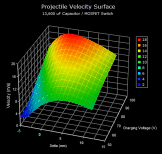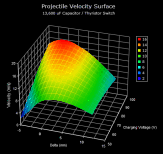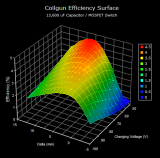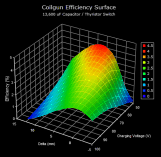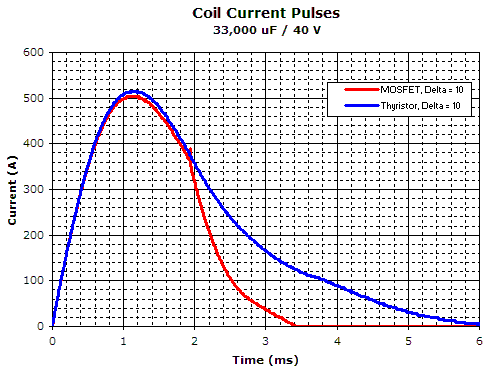
|
Thyristor Fired Coilgun Conclusions
Referring to figures 1 - 4 below we can see that, compared to a MOSFET switched coil with closed loop control and suckback reduction, the thyristor fired coilgun falls a little short in terms of peak velocity and efficiency. Of particular significance is the more rapid fall off in velocity and efficiency as the launch position is advanced beyond the VPD, especially at higher voltages. Again, note the reorientation of the axes between velocity and efficiency graphs. The natural pulse width, as set by the choice of capacitor, has a strong effect on the sensitivity to delta for a given voltage. This is evidenced by the poor velocity developed with the 33,000 uF capacitor as delta is increased. In fact, suckback can stop the projectile dead in the tube under certain conditions. The extended current tail produced when using badly matched parameters can be clearly seen in fig 5. For this particular combination of voltage, capacitance and delta, the thyristor switch produces a peak velocity and efficiency of 5.1 m/s and 0.65 % respectively. Contrast this with the MOSFET switching arrangement that produces a peak velocity and efficiency of 11.3 m/s and 4.1 % respectively. Notice that the peak current is slightly greater when using the thyristor. This is probably due to the slightly lower dynamic resistance of the thyristor. Although the thyristor fired coilgun exhibits a smaller global maximum for both velocity and efficiency, it must be remembered that there was no attempt to reduce suckback. In favour of the MOSFET we can say that this switch type allows much more flexibility in the choice of capacitance than is possible with this simple thyristor setup. In fact, there's no theoretical upper limit to the capacitance that can be employed when using a MOSFET switch. In summary it can be said that, due to the high pulsed current rating for its physical size, and the modest triggering requirements, the thyristor is an effective switching device for use in coilgun applications. If suckback control measures are implemented then the thyristor can compete with MOSFET switches under certain coil-capacitor combinations.
Fig 5. MOSFET and thyristor-fired current pulses.
|
|


